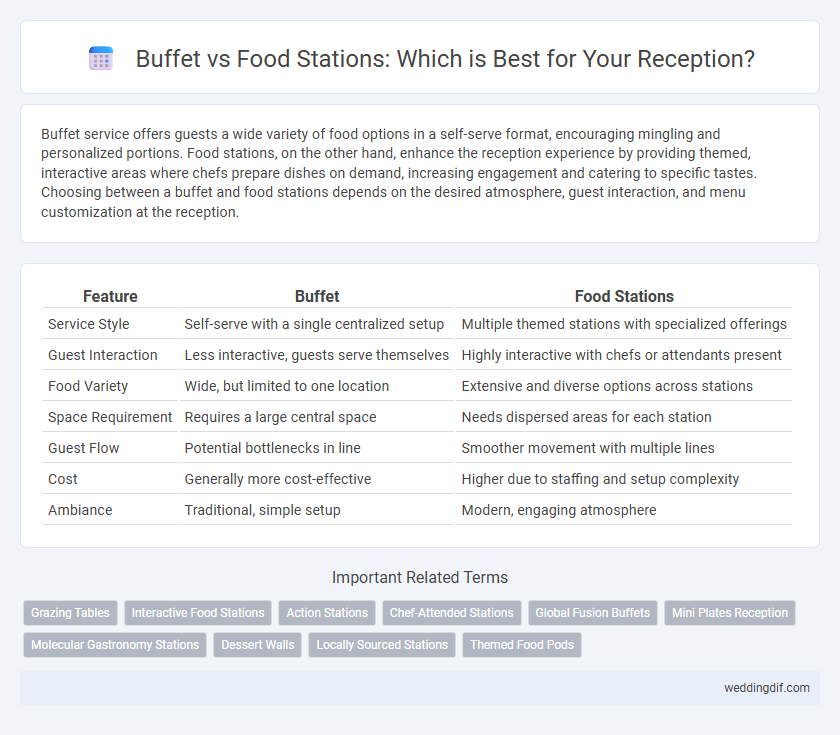Buffet service offers guests a wide variety of food options in a self-serve format, encouraging mingling and personalized portions. Food stations, on the other hand, enhance the reception experience by providing themed, interactive areas where chefs prepare dishes on demand, increasing engagement and catering to specific tastes. Choosing between a buffet and food stations depends on the desired atmosphere, guest interaction, and menu customization at the reception.
Table of Comparison
| Feature | Buffet | Food Stations |
|---|---|---|
| Service Style | Self-serve with a single centralized setup | Multiple themed stations with specialized offerings |
| Guest Interaction | Less interactive, guests serve themselves | Highly interactive with chefs or attendants present |
| Food Variety | Wide, but limited to one location | Extensive and diverse options across stations |
| Space Requirement | Requires a large central space | Needs dispersed areas for each station |
| Guest Flow | Potential bottlenecks in line | Smoother movement with multiple lines |
| Cost | Generally more cost-effective | Higher due to staffing and setup complexity |
| Ambiance | Traditional, simple setup | Modern, engaging atmosphere |
Understanding Wedding Buffet Receptions
Wedding buffet receptions offer guests the flexibility to choose from a variety of dishes served in a self-serve layout, promoting a relaxed and social atmosphere. Buffets typically accommodate large groups efficiently, ensuring faster service compared to individually plated meals. Food stations, by contrast, provide themed or specialized cuisine at different areas, encouraging interaction but requiring more space and staff.
What Are Food Stations at Wedding Receptions?
Food stations at wedding receptions are interactive culinary setups where guests can customize their meals from a variety of themed options, such as sushi bars, taco stands, or carving stations. Unlike traditional buffets, food stations encourage socializing and offer a dynamic dining experience by serving freshly prepared dishes made to order. This format enhances guest engagement and allows for diverse menu selections tailored to different tastes and dietary preferences.
Key Differences: Buffets vs Food Stations
Buffets offer a self-serve style where guests can choose from a variety of dishes laid out on a single table, promoting convenience and efficiency in large receptions. Food stations provide multiple themed areas with chefs preparing food on-site, creating interactive experiences and customized options for guests. Key differences include the level of guest engagement, variety presentation, and the overall ambiance each setup creates during the event.
Guest Experience: Engagement and Interaction
Buffet-style receptions offer guests straightforward access to a wide variety of dishes, allowing for quick selections but often limiting personalized interaction with serving staff. Food stations enhance guest engagement by enabling direct communication with chefs or attendants, creating an interactive culinary experience tailored to individual preferences. Incorporating food stations can elevate the overall guest experience by fostering social interaction and providing unique, customized dining options.
Menu Variety and Customization
Buffet receptions offer a wide array of menu options allowing guests to sample multiple dishes, enhancing menu variety and guest satisfaction. Food stations provide customizable choices tailored to specific preferences or dietary needs, creating an interactive dining experience that elevates personalization. Both options improve menu flexibility but food stations excel in delivering specialized, made-to-order selections during the event.
Space and Layout Considerations
Buffet setups require ample linear space for guests to move smoothly along a single serving line, ensuring efficient flow and minimizing congestion. Food stations allow flexible placement throughout the reception area, optimizing spatial use by breaking up guest traffic into smaller, manageable groups. Careful layout planning for food stations enhances guest experience by reducing wait times and encouraging mingling in different zones.
Timing and Flow of Service
Buffet service allows guests to serve themselves at their convenience, promoting a relaxed flow and minimizing wait times during peak moments. Food stations, organized by specific dishes or cuisines, encourage guests to circulate and sample various options, enhancing interaction and reducing bottlenecks at any single point. Efficient timing in both setups depends on strategic placement and staffing to maintain smooth movement and continuous replenishment.
Budget Implications: Cost Comparison
Buffet options generally offer a lower cost per guest due to bulk food preparation and simplified service, making them budget-friendly for larger receptions. Food stations often require more staffing and specialized ingredients, increasing overall expenses but providing a varied dining experience. Choosing between buffet and food stations depends on balancing budget constraints with desired guest interaction and menu diversity.
Pros and Cons of Buffets for Weddings
Buffets at weddings offer guests variety and flexibility, allowing them to choose portions and dishes according to their preferences, which can enhance overall satisfaction. However, buffets may lead to longer wait times and potential food waste, especially with large guest lists, impacting the flow of the reception. Cost-effectiveness and efficient staff management are advantages, but maintaining food temperature and presentation requires careful planning to ensure quality throughout the event.
Pros and Cons of Food Stations for Receptions
Food stations at receptions offer guests diverse, customizable dining experiences tailored to individual preferences, enhancing engagement and satisfaction. They reduce long lines and wait times compared to traditional buffets, promoting smoother service flow and guest interaction. However, food stations may require increased staffing and space, potentially raising costs and complicating logistical planning.
Buffet vs Food Stations for Reception. Infographic

 weddingdif.com
weddingdif.com